A Critical Literature Review of Nurses' Experiences During COVID-19
VerifiedAdded on 2023/06/14
|9
|2812
|432
Literature Review
AI Summary
This critical literature review explores the experiences and challenges faced by nurses caring for COVID-19 patients. It examines the review's purpose, eligibility criteria, types of studies included, databases searched, and search terms used. The review assesses the suitability of search terms, applied search limits, and the PRISMA flowchart's adequacy in describing article identification and selection. It identifies the critical appraisal instruments used to determine methodological quality and discusses the summarization of included studies, exclusion of studies, data abstraction and synthesis methods, and critique of reviewed studies including limitations. The review also assesses the level of evidence based on the JBI hierarchy and suggests how the information can be applied in clinical practice for knowledge transfer, highlighting the importance of understanding and addressing the challenges faced by nurses during the pandemic.
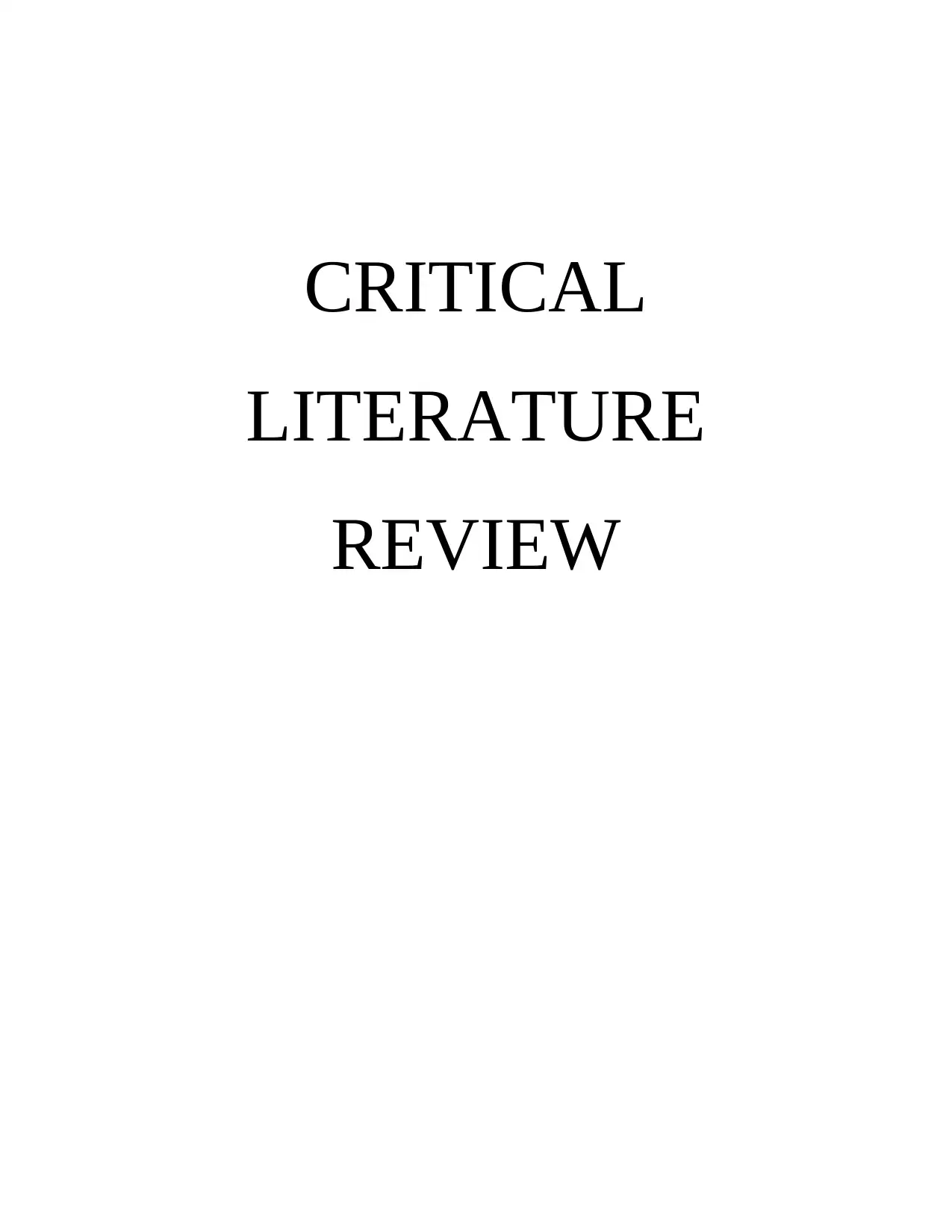
CRITICAL
LITERATURE
REVIEW
LITERATURE
REVIEW
Paraphrase This Document
Need a fresh take? Get an instant paraphrase of this document with our AI Paraphraser
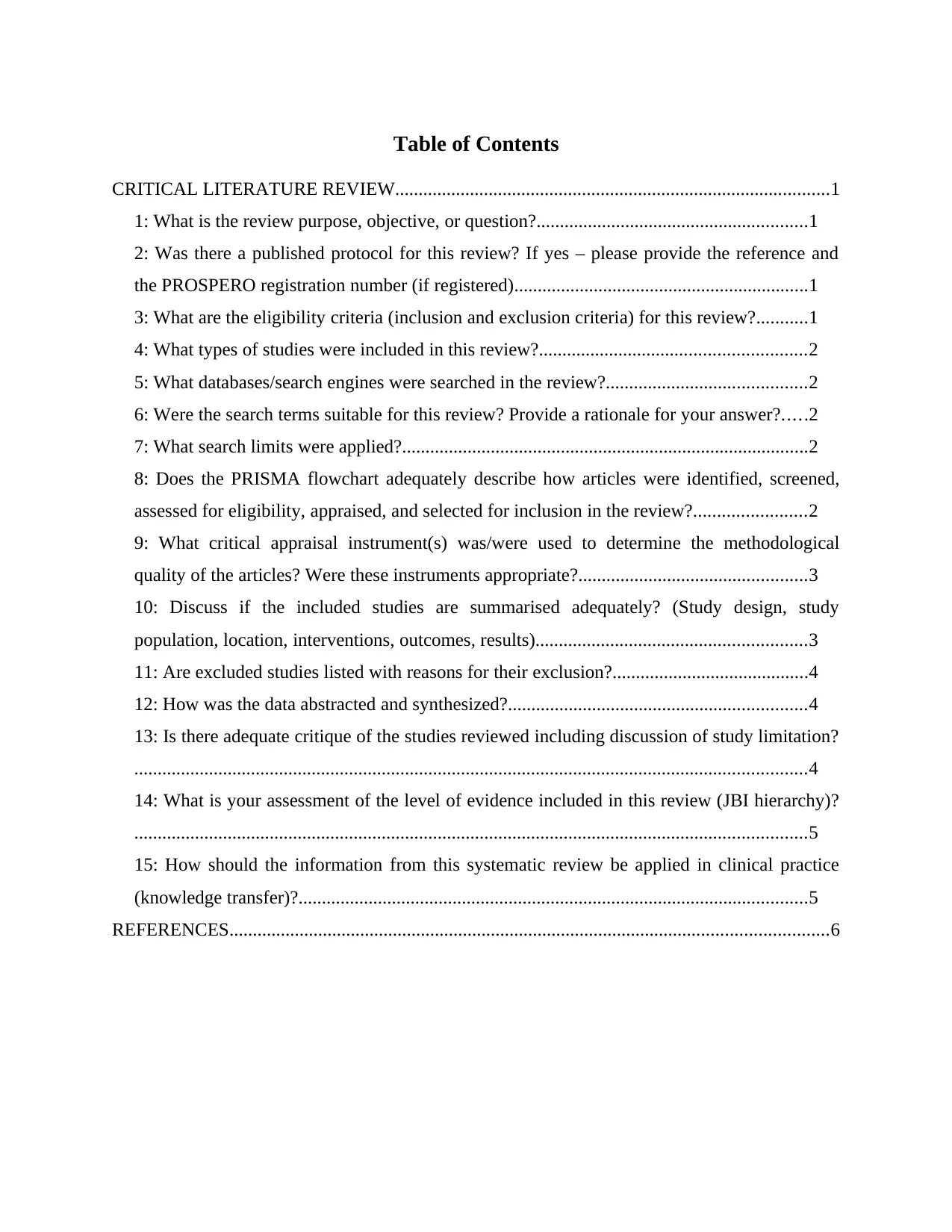
Table of Contents
CRITICAL LITERATURE REVIEW.............................................................................................1
1: What is the review purpose, objective, or question?..........................................................1
2: Was there a published protocol for this review? If yes – please provide the reference and
the PROSPERO registration number (if registered)...............................................................1
3: What are the eligibility criteria (inclusion and exclusion criteria) for this review?...........1
4: What types of studies were included in this review?.........................................................2
5: What databases/search engines were searched in the review?...........................................2
6: Were the search terms suitable for this review? Provide a rationale for your answer?.....2
7: What search limits were applied?.......................................................................................2
8: Does the PRISMA flowchart adequately describe how articles were identified, screened,
assessed for eligibility, appraised, and selected for inclusion in the review?........................2
9: What critical appraisal instrument(s) was/were used to determine the methodological
quality of the articles? Were these instruments appropriate?.................................................3
10: Discuss if the included studies are summarised adequately? (Study design, study
population, location, interventions, outcomes, results)..........................................................3
11: Are excluded studies listed with reasons for their exclusion?..........................................4
12: How was the data abstracted and synthesized?................................................................4
13: Is there adequate critique of the studies reviewed including discussion of study limitation?
................................................................................................................................................4
14: What is your assessment of the level of evidence included in this review (JBI hierarchy)?
................................................................................................................................................5
15: How should the information from this systematic review be applied in clinical practice
(knowledge transfer)?.............................................................................................................5
REFERENCES................................................................................................................................6
CRITICAL LITERATURE REVIEW.............................................................................................1
1: What is the review purpose, objective, or question?..........................................................1
2: Was there a published protocol for this review? If yes – please provide the reference and
the PROSPERO registration number (if registered)...............................................................1
3: What are the eligibility criteria (inclusion and exclusion criteria) for this review?...........1
4: What types of studies were included in this review?.........................................................2
5: What databases/search engines were searched in the review?...........................................2
6: Were the search terms suitable for this review? Provide a rationale for your answer?.....2
7: What search limits were applied?.......................................................................................2
8: Does the PRISMA flowchart adequately describe how articles were identified, screened,
assessed for eligibility, appraised, and selected for inclusion in the review?........................2
9: What critical appraisal instrument(s) was/were used to determine the methodological
quality of the articles? Were these instruments appropriate?.................................................3
10: Discuss if the included studies are summarised adequately? (Study design, study
population, location, interventions, outcomes, results)..........................................................3
11: Are excluded studies listed with reasons for their exclusion?..........................................4
12: How was the data abstracted and synthesized?................................................................4
13: Is there adequate critique of the studies reviewed including discussion of study limitation?
................................................................................................................................................4
14: What is your assessment of the level of evidence included in this review (JBI hierarchy)?
................................................................................................................................................5
15: How should the information from this systematic review be applied in clinical practice
(knowledge transfer)?.............................................................................................................5
REFERENCES................................................................................................................................6
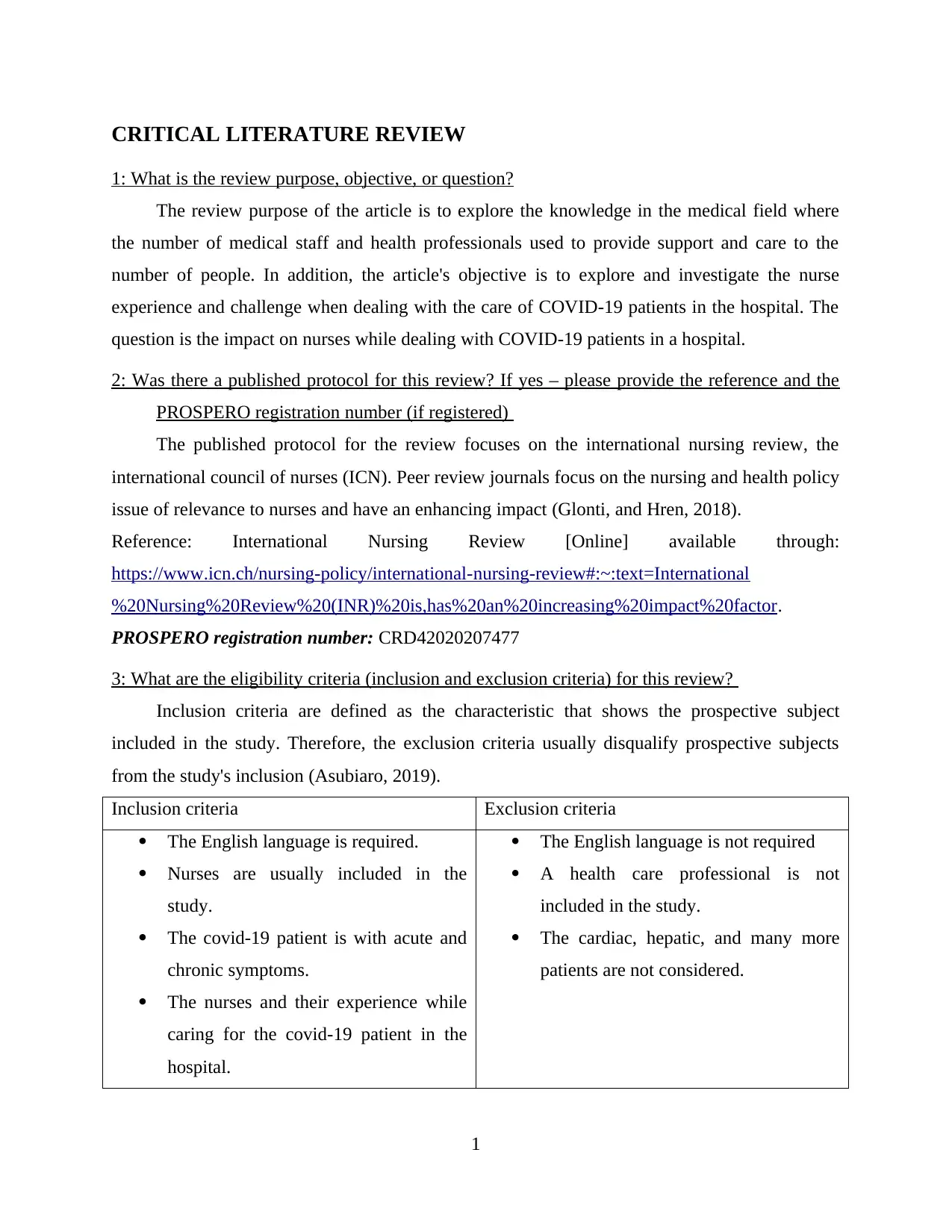
CRITICAL LITERATURE REVIEW
1: What is the review purpose, objective, or question?
The review purpose of the article is to explore the knowledge in the medical field where
the number of medical staff and health professionals used to provide support and care to the
number of people. In addition, the article's objective is to explore and investigate the nurse
experience and challenge when dealing with the care of COVID-19 patients in the hospital. The
question is the impact on nurses while dealing with COVID-19 patients in a hospital.
2: Was there a published protocol for this review? If yes – please provide the reference and the
PROSPERO registration number (if registered)
The published protocol for the review focuses on the international nursing review, the
international council of nurses (ICN). Peer review journals focus on the nursing and health policy
issue of relevance to nurses and have an enhancing impact (Glonti, and Hren, 2018).
Reference: International Nursing Review [Online] available through:
https://www.icn.ch/nursing-policy/international-nursing-review#:~:text=International
%20Nursing%20Review%20(INR)%20is,has%20an%20increasing%20impact%20factor.
PROSPERO registration number: CRD42020207477
3: What are the eligibility criteria (inclusion and exclusion criteria) for this review?
Inclusion criteria are defined as the characteristic that shows the prospective subject
included in the study. Therefore, the exclusion criteria usually disqualify prospective subjects
from the study's inclusion (Asubiaro, 2019).
Inclusion criteria Exclusion criteria
The English language is required.
Nurses are usually included in the
study.
The covid-19 patient is with acute and
chronic symptoms.
The nurses and their experience while
caring for the covid-19 patient in the
hospital.
The English language is not required
A health care professional is not
included in the study.
The cardiac, hepatic, and many more
patients are not considered.
1
1: What is the review purpose, objective, or question?
The review purpose of the article is to explore the knowledge in the medical field where
the number of medical staff and health professionals used to provide support and care to the
number of people. In addition, the article's objective is to explore and investigate the nurse
experience and challenge when dealing with the care of COVID-19 patients in the hospital. The
question is the impact on nurses while dealing with COVID-19 patients in a hospital.
2: Was there a published protocol for this review? If yes – please provide the reference and the
PROSPERO registration number (if registered)
The published protocol for the review focuses on the international nursing review, the
international council of nurses (ICN). Peer review journals focus on the nursing and health policy
issue of relevance to nurses and have an enhancing impact (Glonti, and Hren, 2018).
Reference: International Nursing Review [Online] available through:
https://www.icn.ch/nursing-policy/international-nursing-review#:~:text=International
%20Nursing%20Review%20(INR)%20is,has%20an%20increasing%20impact%20factor.
PROSPERO registration number: CRD42020207477
3: What are the eligibility criteria (inclusion and exclusion criteria) for this review?
Inclusion criteria are defined as the characteristic that shows the prospective subject
included in the study. Therefore, the exclusion criteria usually disqualify prospective subjects
from the study's inclusion (Asubiaro, 2019).
Inclusion criteria Exclusion criteria
The English language is required.
Nurses are usually included in the
study.
The covid-19 patient is with acute and
chronic symptoms.
The nurses and their experience while
caring for the covid-19 patient in the
hospital.
The English language is not required
A health care professional is not
included in the study.
The cardiac, hepatic, and many more
patients are not considered.
1
⊘ This is a preview!⊘
Do you want full access?
Subscribe today to unlock all pages.

Trusted by 1+ million students worldwide
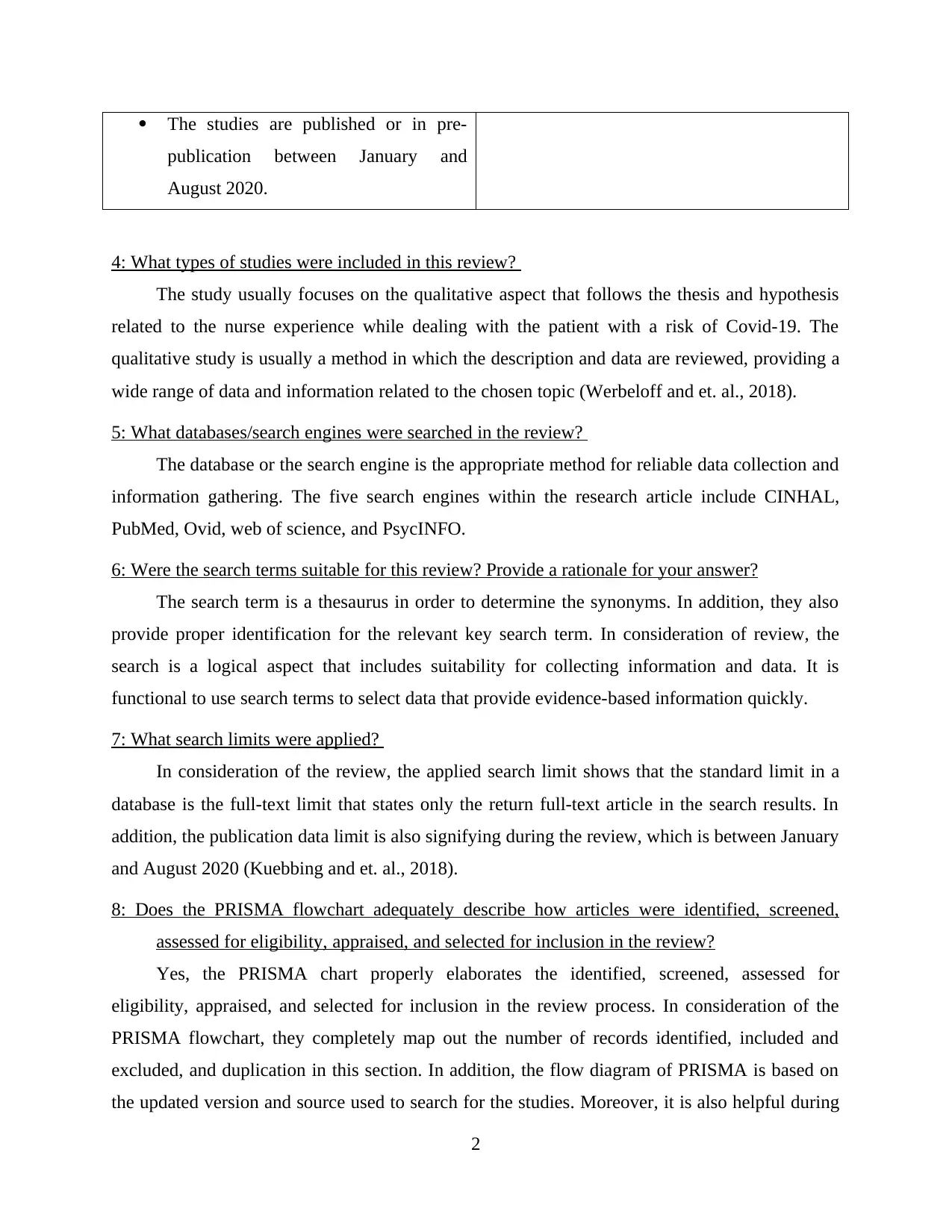
The studies are published or in pre-
publication between January and
August 2020.
4: What types of studies were included in this review?
The study usually focuses on the qualitative aspect that follows the thesis and hypothesis
related to the nurse experience while dealing with the patient with a risk of Covid-19. The
qualitative study is usually a method in which the description and data are reviewed, providing a
wide range of data and information related to the chosen topic (Werbeloff and et. al., 2018).
5: What databases/search engines were searched in the review?
The database or the search engine is the appropriate method for reliable data collection and
information gathering. The five search engines within the research article include CINHAL,
PubMed, Ovid, web of science, and PsycINFO.
6: Were the search terms suitable for this review? Provide a rationale for your answer?
The search term is a thesaurus in order to determine the synonyms. In addition, they also
provide proper identification for the relevant key search term. In consideration of review, the
search is a logical aspect that includes suitability for collecting information and data. It is
functional to use search terms to select data that provide evidence-based information quickly.
7: What search limits were applied?
In consideration of the review, the applied search limit shows that the standard limit in a
database is the full-text limit that states only the return full-text article in the search results. In
addition, the publication data limit is also signifying during the review, which is between January
and August 2020 (Kuebbing and et. al., 2018).
8: Does the PRISMA flowchart adequately describe how articles were identified, screened,
assessed for eligibility, appraised, and selected for inclusion in the review?
Yes, the PRISMA chart properly elaborates the identified, screened, assessed for
eligibility, appraised, and selected for inclusion in the review process. In consideration of the
PRISMA flowchart, they completely map out the number of records identified, included and
excluded, and duplication in this section. In addition, the flow diagram of PRISMA is based on
the updated version and source used to search for the studies. Moreover, it is also helpful during
2
publication between January and
August 2020.
4: What types of studies were included in this review?
The study usually focuses on the qualitative aspect that follows the thesis and hypothesis
related to the nurse experience while dealing with the patient with a risk of Covid-19. The
qualitative study is usually a method in which the description and data are reviewed, providing a
wide range of data and information related to the chosen topic (Werbeloff and et. al., 2018).
5: What databases/search engines were searched in the review?
The database or the search engine is the appropriate method for reliable data collection and
information gathering. The five search engines within the research article include CINHAL,
PubMed, Ovid, web of science, and PsycINFO.
6: Were the search terms suitable for this review? Provide a rationale for your answer?
The search term is a thesaurus in order to determine the synonyms. In addition, they also
provide proper identification for the relevant key search term. In consideration of review, the
search is a logical aspect that includes suitability for collecting information and data. It is
functional to use search terms to select data that provide evidence-based information quickly.
7: What search limits were applied?
In consideration of the review, the applied search limit shows that the standard limit in a
database is the full-text limit that states only the return full-text article in the search results. In
addition, the publication data limit is also signifying during the review, which is between January
and August 2020 (Kuebbing and et. al., 2018).
8: Does the PRISMA flowchart adequately describe how articles were identified, screened,
assessed for eligibility, appraised, and selected for inclusion in the review?
Yes, the PRISMA chart properly elaborates the identified, screened, assessed for
eligibility, appraised, and selected for inclusion in the review process. In consideration of the
PRISMA flowchart, they completely map out the number of records identified, included and
excluded, and duplication in this section. In addition, the flow diagram of PRISMA is based on
the updated version and source used to search for the studies. Moreover, it is also helpful during
2
Paraphrase This Document
Need a fresh take? Get an instant paraphrase of this document with our AI Paraphraser
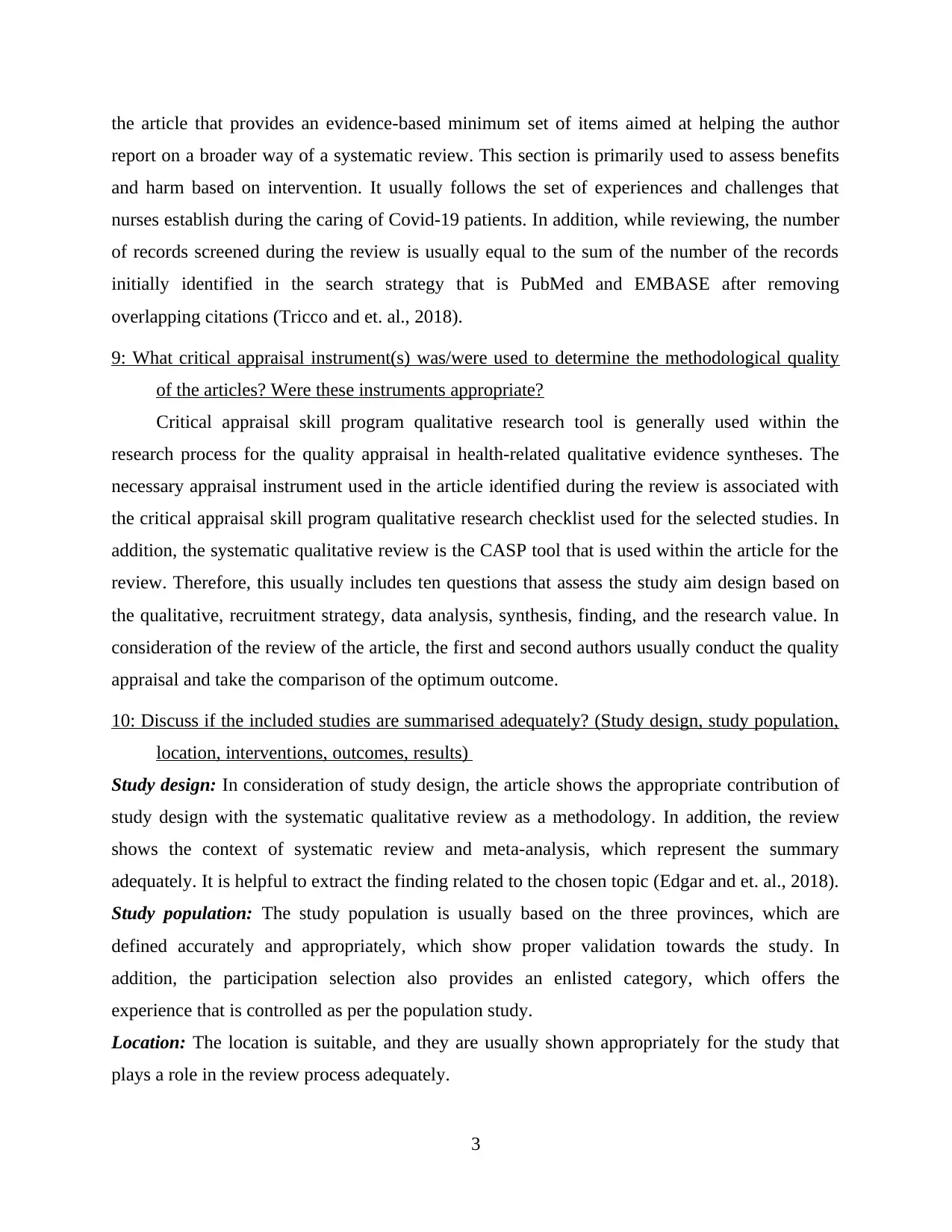
the article that provides an evidence-based minimum set of items aimed at helping the author
report on a broader way of a systematic review. This section is primarily used to assess benefits
and harm based on intervention. It usually follows the set of experiences and challenges that
nurses establish during the caring of Covid-19 patients. In addition, while reviewing, the number
of records screened during the review is usually equal to the sum of the number of the records
initially identified in the search strategy that is PubMed and EMBASE after removing
overlapping citations (Tricco and et. al., 2018).
9: What critical appraisal instrument(s) was/were used to determine the methodological quality
of the articles? Were these instruments appropriate?
Critical appraisal skill program qualitative research tool is generally used within the
research process for the quality appraisal in health-related qualitative evidence syntheses. The
necessary appraisal instrument used in the article identified during the review is associated with
the critical appraisal skill program qualitative research checklist used for the selected studies. In
addition, the systematic qualitative review is the CASP tool that is used within the article for the
review. Therefore, this usually includes ten questions that assess the study aim design based on
the qualitative, recruitment strategy, data analysis, synthesis, finding, and the research value. In
consideration of the review of the article, the first and second authors usually conduct the quality
appraisal and take the comparison of the optimum outcome.
10: Discuss if the included studies are summarised adequately? (Study design, study population,
location, interventions, outcomes, results)
Study design: In consideration of study design, the article shows the appropriate contribution of
study design with the systematic qualitative review as a methodology. In addition, the review
shows the context of systematic review and meta-analysis, which represent the summary
adequately. It is helpful to extract the finding related to the chosen topic (Edgar and et. al., 2018).
Study population: The study population is usually based on the three provinces, which are
defined accurately and appropriately, which show proper validation towards the study. In
addition, the participation selection also provides an enlisted category, which offers the
experience that is controlled as per the population study.
Location: The location is suitable, and they are usually shown appropriately for the study that
plays a role in the review process adequately.
3
report on a broader way of a systematic review. This section is primarily used to assess benefits
and harm based on intervention. It usually follows the set of experiences and challenges that
nurses establish during the caring of Covid-19 patients. In addition, while reviewing, the number
of records screened during the review is usually equal to the sum of the number of the records
initially identified in the search strategy that is PubMed and EMBASE after removing
overlapping citations (Tricco and et. al., 2018).
9: What critical appraisal instrument(s) was/were used to determine the methodological quality
of the articles? Were these instruments appropriate?
Critical appraisal skill program qualitative research tool is generally used within the
research process for the quality appraisal in health-related qualitative evidence syntheses. The
necessary appraisal instrument used in the article identified during the review is associated with
the critical appraisal skill program qualitative research checklist used for the selected studies. In
addition, the systematic qualitative review is the CASP tool that is used within the article for the
review. Therefore, this usually includes ten questions that assess the study aim design based on
the qualitative, recruitment strategy, data analysis, synthesis, finding, and the research value. In
consideration of the review of the article, the first and second authors usually conduct the quality
appraisal and take the comparison of the optimum outcome.
10: Discuss if the included studies are summarised adequately? (Study design, study population,
location, interventions, outcomes, results)
Study design: In consideration of study design, the article shows the appropriate contribution of
study design with the systematic qualitative review as a methodology. In addition, the review
shows the context of systematic review and meta-analysis, which represent the summary
adequately. It is helpful to extract the finding related to the chosen topic (Edgar and et. al., 2018).
Study population: The study population is usually based on the three provinces, which are
defined accurately and appropriately, which show proper validation towards the study. In
addition, the participation selection also provides an enlisted category, which offers the
experience that is controlled as per the population study.
Location: The location is suitable, and they are usually shown appropriately for the study that
plays a role in the review process adequately.
3
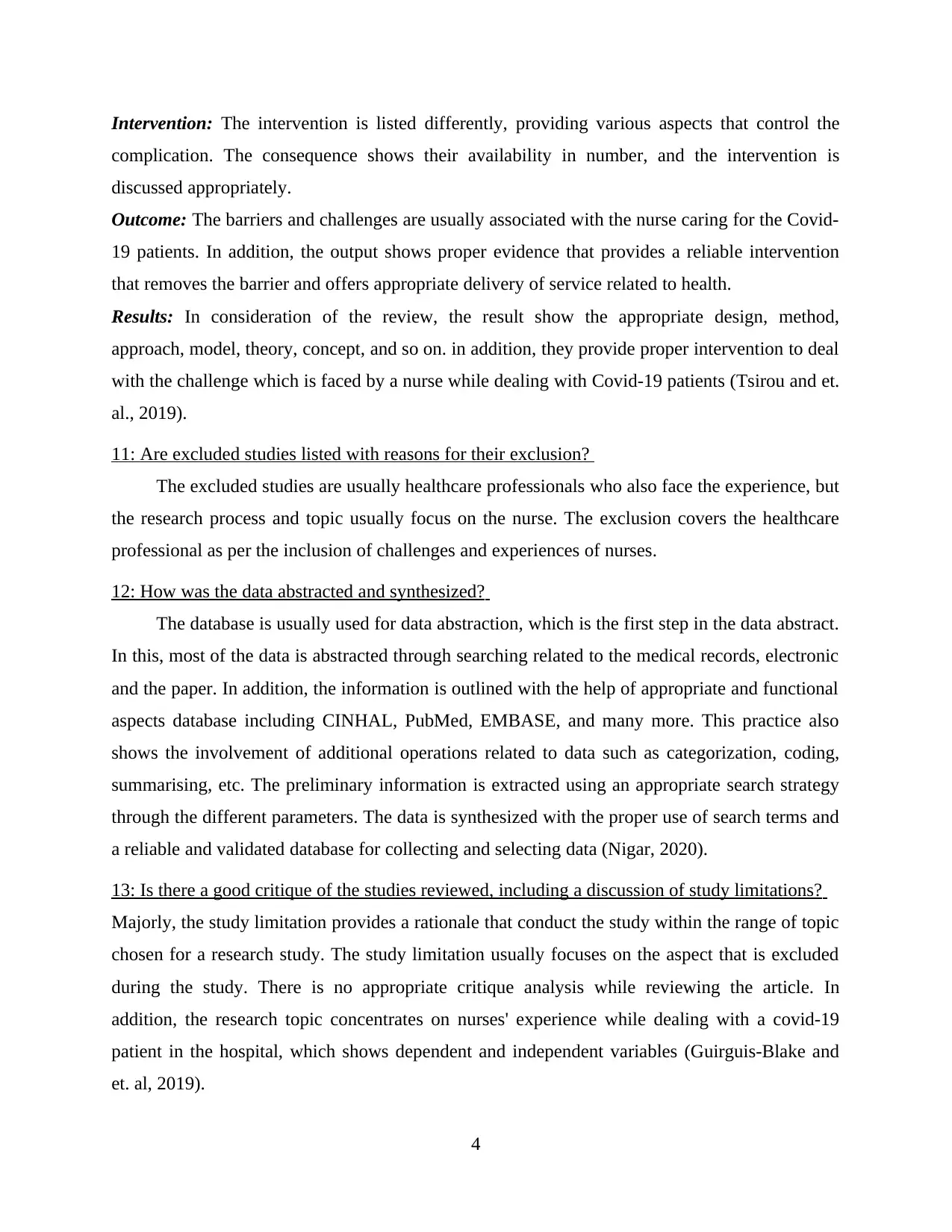
Intervention: The intervention is listed differently, providing various aspects that control the
complication. The consequence shows their availability in number, and the intervention is
discussed appropriately.
Outcome: The barriers and challenges are usually associated with the nurse caring for the Covid-
19 patients. In addition, the output shows proper evidence that provides a reliable intervention
that removes the barrier and offers appropriate delivery of service related to health.
Results: In consideration of the review, the result show the appropriate design, method,
approach, model, theory, concept, and so on. in addition, they provide proper intervention to deal
with the challenge which is faced by a nurse while dealing with Covid-19 patients (Tsirou and et.
al., 2019).
11: Are excluded studies listed with reasons for their exclusion?
The excluded studies are usually healthcare professionals who also face the experience, but
the research process and topic usually focus on the nurse. The exclusion covers the healthcare
professional as per the inclusion of challenges and experiences of nurses.
12: How was the data abstracted and synthesized?
The database is usually used for data abstraction, which is the first step in the data abstract.
In this, most of the data is abstracted through searching related to the medical records, electronic
and the paper. In addition, the information is outlined with the help of appropriate and functional
aspects database including CINHAL, PubMed, EMBASE, and many more. This practice also
shows the involvement of additional operations related to data such as categorization, coding,
summarising, etc. The preliminary information is extracted using an appropriate search strategy
through the different parameters. The data is synthesized with the proper use of search terms and
a reliable and validated database for collecting and selecting data (Nigar, 2020).
13: Is there a good critique of the studies reviewed, including a discussion of study limitations?
Majorly, the study limitation provides a rationale that conduct the study within the range of topic
chosen for a research study. The study limitation usually focuses on the aspect that is excluded
during the study. There is no appropriate critique analysis while reviewing the article. In
addition, the research topic concentrates on nurses' experience while dealing with a covid-19
patient in the hospital, which shows dependent and independent variables (Guirguis-Blake and
et. al, 2019).
4
complication. The consequence shows their availability in number, and the intervention is
discussed appropriately.
Outcome: The barriers and challenges are usually associated with the nurse caring for the Covid-
19 patients. In addition, the output shows proper evidence that provides a reliable intervention
that removes the barrier and offers appropriate delivery of service related to health.
Results: In consideration of the review, the result show the appropriate design, method,
approach, model, theory, concept, and so on. in addition, they provide proper intervention to deal
with the challenge which is faced by a nurse while dealing with Covid-19 patients (Tsirou and et.
al., 2019).
11: Are excluded studies listed with reasons for their exclusion?
The excluded studies are usually healthcare professionals who also face the experience, but
the research process and topic usually focus on the nurse. The exclusion covers the healthcare
professional as per the inclusion of challenges and experiences of nurses.
12: How was the data abstracted and synthesized?
The database is usually used for data abstraction, which is the first step in the data abstract.
In this, most of the data is abstracted through searching related to the medical records, electronic
and the paper. In addition, the information is outlined with the help of appropriate and functional
aspects database including CINHAL, PubMed, EMBASE, and many more. This practice also
shows the involvement of additional operations related to data such as categorization, coding,
summarising, etc. The preliminary information is extracted using an appropriate search strategy
through the different parameters. The data is synthesized with the proper use of search terms and
a reliable and validated database for collecting and selecting data (Nigar, 2020).
13: Is there a good critique of the studies reviewed, including a discussion of study limitations?
Majorly, the study limitation provides a rationale that conduct the study within the range of topic
chosen for a research study. The study limitation usually focuses on the aspect that is excluded
during the study. There is no appropriate critique analysis while reviewing the article. In
addition, the research topic concentrates on nurses' experience while dealing with a covid-19
patient in the hospital, which shows dependent and independent variables (Guirguis-Blake and
et. al, 2019).
4
⊘ This is a preview!⊘
Do you want full access?
Subscribe today to unlock all pages.

Trusted by 1+ million students worldwide
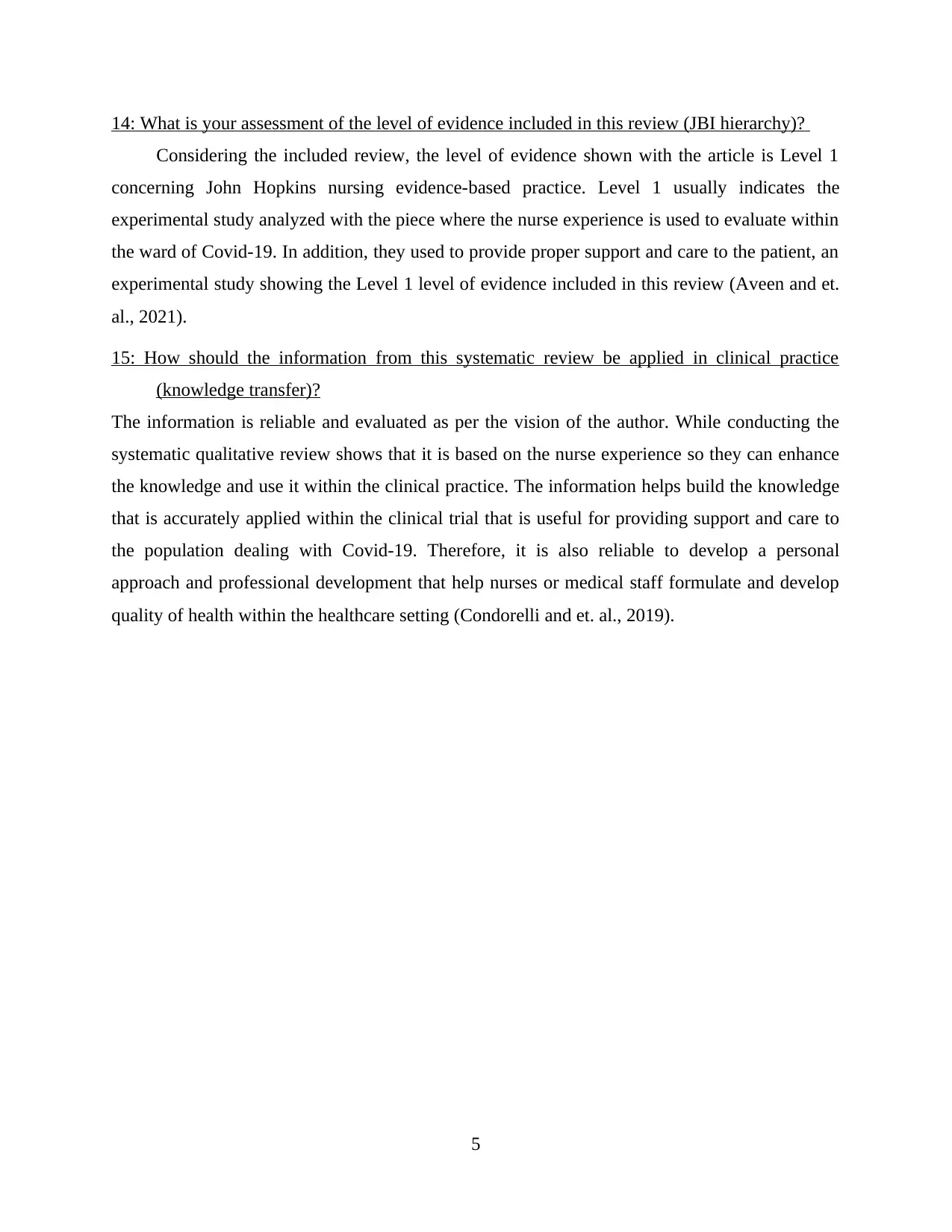
14: What is your assessment of the level of evidence included in this review (JBI hierarchy)?
Considering the included review, the level of evidence shown with the article is Level 1
concerning John Hopkins nursing evidence-based practice. Level 1 usually indicates the
experimental study analyzed with the piece where the nurse experience is used to evaluate within
the ward of Covid-19. In addition, they used to provide proper support and care to the patient, an
experimental study showing the Level 1 level of evidence included in this review (Aveen and et.
al., 2021).
15: How should the information from this systematic review be applied in clinical practice
(knowledge transfer)?
The information is reliable and evaluated as per the vision of the author. While conducting the
systematic qualitative review shows that it is based on the nurse experience so they can enhance
the knowledge and use it within the clinical practice. The information helps build the knowledge
that is accurately applied within the clinical trial that is useful for providing support and care to
the population dealing with Covid-19. Therefore, it is also reliable to develop a personal
approach and professional development that help nurses or medical staff formulate and develop
quality of health within the healthcare setting (Condorelli and et. al., 2019).
5
Considering the included review, the level of evidence shown with the article is Level 1
concerning John Hopkins nursing evidence-based practice. Level 1 usually indicates the
experimental study analyzed with the piece where the nurse experience is used to evaluate within
the ward of Covid-19. In addition, they used to provide proper support and care to the patient, an
experimental study showing the Level 1 level of evidence included in this review (Aveen and et.
al., 2021).
15: How should the information from this systematic review be applied in clinical practice
(knowledge transfer)?
The information is reliable and evaluated as per the vision of the author. While conducting the
systematic qualitative review shows that it is based on the nurse experience so they can enhance
the knowledge and use it within the clinical practice. The information helps build the knowledge
that is accurately applied within the clinical trial that is useful for providing support and care to
the population dealing with Covid-19. Therefore, it is also reliable to develop a personal
approach and professional development that help nurses or medical staff formulate and develop
quality of health within the healthcare setting (Condorelli and et. al., 2019).
5
Paraphrase This Document
Need a fresh take? Get an instant paraphrase of this document with our AI Paraphraser
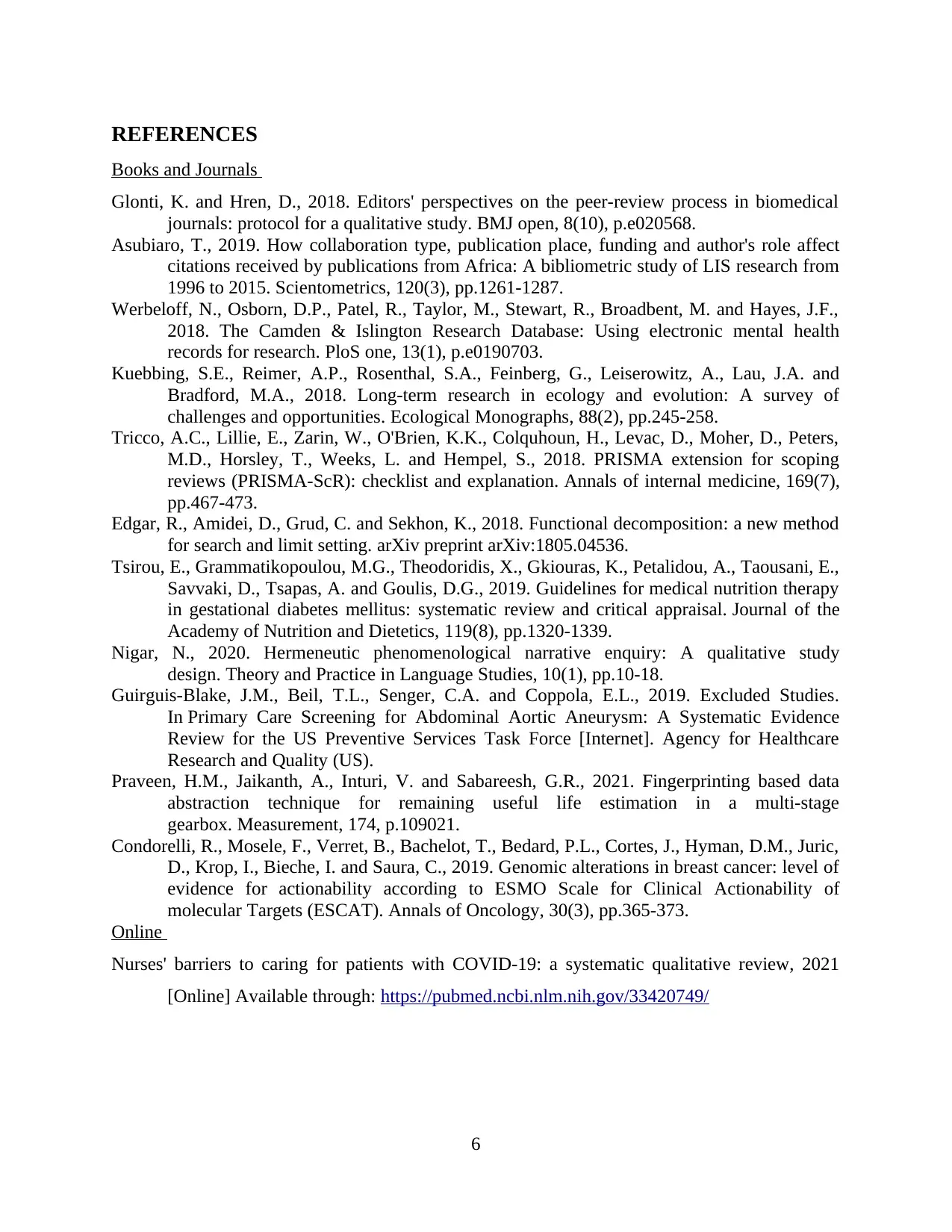
REFERENCES
Books and Journals
Glonti, K. and Hren, D., 2018. Editors' perspectives on the peer-review process in biomedical
journals: protocol for a qualitative study. BMJ open, 8(10), p.e020568.
Asubiaro, T., 2019. How collaboration type, publication place, funding and author's role affect
citations received by publications from Africa: A bibliometric study of LIS research from
1996 to 2015. Scientometrics, 120(3), pp.1261-1287.
Werbeloff, N., Osborn, D.P., Patel, R., Taylor, M., Stewart, R., Broadbent, M. and Hayes, J.F.,
2018. The Camden & Islington Research Database: Using electronic mental health
records for research. PloS one, 13(1), p.e0190703.
Kuebbing, S.E., Reimer, A.P., Rosenthal, S.A., Feinberg, G., Leiserowitz, A., Lau, J.A. and
Bradford, M.A., 2018. Long‐term research in ecology and evolution: A survey of
challenges and opportunities. Ecological Monographs, 88(2), pp.245-258.
Tricco, A.C., Lillie, E., Zarin, W., O'Brien, K.K., Colquhoun, H., Levac, D., Moher, D., Peters,
M.D., Horsley, T., Weeks, L. and Hempel, S., 2018. PRISMA extension for scoping
reviews (PRISMA-ScR): checklist and explanation. Annals of internal medicine, 169(7),
pp.467-473.
Edgar, R., Amidei, D., Grud, C. and Sekhon, K., 2018. Functional decomposition: a new method
for search and limit setting. arXiv preprint arXiv:1805.04536.
Tsirou, E., Grammatikopoulou, M.G., Theodoridis, X., Gkiouras, K., Petalidou, A., Taousani, E.,
Savvaki, D., Tsapas, A. and Goulis, D.G., 2019. Guidelines for medical nutrition therapy
in gestational diabetes mellitus: systematic review and critical appraisal. Journal of the
Academy of Nutrition and Dietetics, 119(8), pp.1320-1339.
Nigar, N., 2020. Hermeneutic phenomenological narrative enquiry: A qualitative study
design. Theory and Practice in Language Studies, 10(1), pp.10-18.
Guirguis-Blake, J.M., Beil, T.L., Senger, C.A. and Coppola, E.L., 2019. Excluded Studies.
In Primary Care Screening for Abdominal Aortic Aneurysm: A Systematic Evidence
Review for the US Preventive Services Task Force [Internet]. Agency for Healthcare
Research and Quality (US).
Praveen, H.M., Jaikanth, A., Inturi, V. and Sabareesh, G.R., 2021. Fingerprinting based data
abstraction technique for remaining useful life estimation in a multi-stage
gearbox. Measurement, 174, p.109021.
Condorelli, R., Mosele, F., Verret, B., Bachelot, T., Bedard, P.L., Cortes, J., Hyman, D.M., Juric,
D., Krop, I., Bieche, I. and Saura, C., 2019. Genomic alterations in breast cancer: level of
evidence for actionability according to ESMO Scale for Clinical Actionability of
molecular Targets (ESCAT). Annals of Oncology, 30(3), pp.365-373.
Online
Nurses' barriers to caring for patients with COVID-19: a systematic qualitative review, 2021
[Online] Available through: https://pubmed.ncbi.nlm.nih.gov/33420749/
6
Books and Journals
Glonti, K. and Hren, D., 2018. Editors' perspectives on the peer-review process in biomedical
journals: protocol for a qualitative study. BMJ open, 8(10), p.e020568.
Asubiaro, T., 2019. How collaboration type, publication place, funding and author's role affect
citations received by publications from Africa: A bibliometric study of LIS research from
1996 to 2015. Scientometrics, 120(3), pp.1261-1287.
Werbeloff, N., Osborn, D.P., Patel, R., Taylor, M., Stewart, R., Broadbent, M. and Hayes, J.F.,
2018. The Camden & Islington Research Database: Using electronic mental health
records for research. PloS one, 13(1), p.e0190703.
Kuebbing, S.E., Reimer, A.P., Rosenthal, S.A., Feinberg, G., Leiserowitz, A., Lau, J.A. and
Bradford, M.A., 2018. Long‐term research in ecology and evolution: A survey of
challenges and opportunities. Ecological Monographs, 88(2), pp.245-258.
Tricco, A.C., Lillie, E., Zarin, W., O'Brien, K.K., Colquhoun, H., Levac, D., Moher, D., Peters,
M.D., Horsley, T., Weeks, L. and Hempel, S., 2018. PRISMA extension for scoping
reviews (PRISMA-ScR): checklist and explanation. Annals of internal medicine, 169(7),
pp.467-473.
Edgar, R., Amidei, D., Grud, C. and Sekhon, K., 2018. Functional decomposition: a new method
for search and limit setting. arXiv preprint arXiv:1805.04536.
Tsirou, E., Grammatikopoulou, M.G., Theodoridis, X., Gkiouras, K., Petalidou, A., Taousani, E.,
Savvaki, D., Tsapas, A. and Goulis, D.G., 2019. Guidelines for medical nutrition therapy
in gestational diabetes mellitus: systematic review and critical appraisal. Journal of the
Academy of Nutrition and Dietetics, 119(8), pp.1320-1339.
Nigar, N., 2020. Hermeneutic phenomenological narrative enquiry: A qualitative study
design. Theory and Practice in Language Studies, 10(1), pp.10-18.
Guirguis-Blake, J.M., Beil, T.L., Senger, C.A. and Coppola, E.L., 2019. Excluded Studies.
In Primary Care Screening for Abdominal Aortic Aneurysm: A Systematic Evidence
Review for the US Preventive Services Task Force [Internet]. Agency for Healthcare
Research and Quality (US).
Praveen, H.M., Jaikanth, A., Inturi, V. and Sabareesh, G.R., 2021. Fingerprinting based data
abstraction technique for remaining useful life estimation in a multi-stage
gearbox. Measurement, 174, p.109021.
Condorelli, R., Mosele, F., Verret, B., Bachelot, T., Bedard, P.L., Cortes, J., Hyman, D.M., Juric,
D., Krop, I., Bieche, I. and Saura, C., 2019. Genomic alterations in breast cancer: level of
evidence for actionability according to ESMO Scale for Clinical Actionability of
molecular Targets (ESCAT). Annals of Oncology, 30(3), pp.365-373.
Online
Nurses' barriers to caring for patients with COVID-19: a systematic qualitative review, 2021
[Online] Available through: https://pubmed.ncbi.nlm.nih.gov/33420749/
6

7
⊘ This is a preview!⊘
Do you want full access?
Subscribe today to unlock all pages.

Trusted by 1+ million students worldwide
1 out of 9
Related Documents
Your All-in-One AI-Powered Toolkit for Academic Success.
+13062052269
info@desklib.com
Available 24*7 on WhatsApp / Email
![[object Object]](/_next/static/media/star-bottom.7253800d.svg)
Unlock your academic potential
Copyright © 2020–2025 A2Z Services. All Rights Reserved. Developed and managed by ZUCOL.





